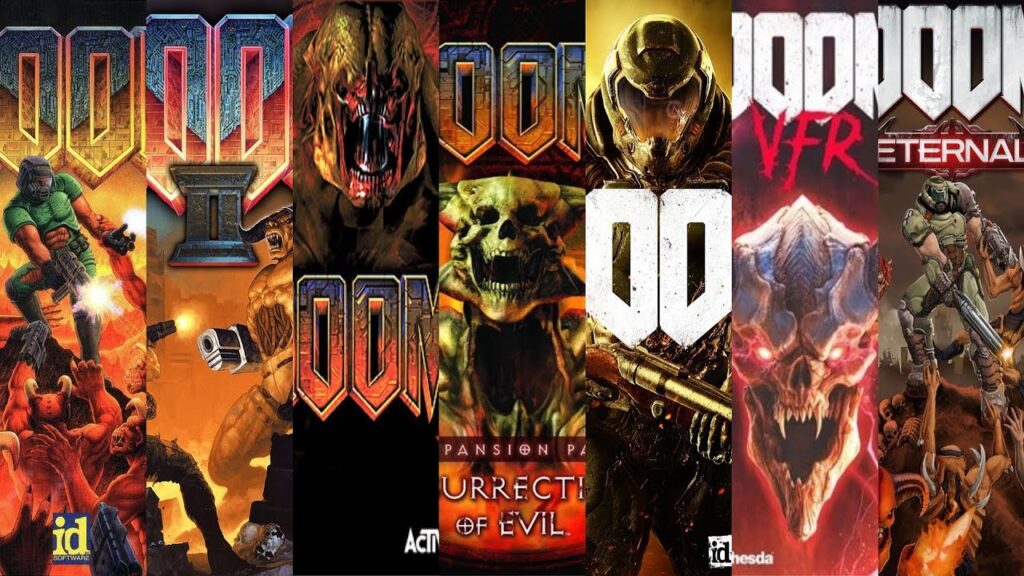The Doom franchise has contributed significantly to the evolution of action games, from immersive 3D graphics and fast-paced gameplay to complex storylines and multiplayer modes. The original Doom set the standard for future action games, introducing gameplay mechanics still popular today. The rise of first-person shooters in the late 1990s saw Doom continue to evolve, with more realistic graphics and horror elements. In 2016, Doom was rebooted, focusing on brutal combat and impressive demon designs. The latest installment, Doom Eternal, offers an even more intense and challenging experience, with refined gameplay mechanics and an integrated multiplayer mode called Battlemode.
The Evolution of Action Games: From Doom to Doom Eternal
Action games have come a long way since the days of pixelated graphics and basic gameplay mechanics. One series that stands out as a pioneer in this genre is Doom, which has been around for over 25 years. The franchise has seen numerous iterations, from the original 1993 release to the latest installment, Doom Eternal. In this article, we’ll take a detailed look at the evolution of action games, focusing on the Doom series and its contribution to the genre.
The Original Doom: A Game-Changer
Doom was released in 1993, and it quickly became a sensation. It was one of the first games to feature immersive 3D graphics and fast-paced gameplay. The player assumes the role of a marine who must navigate through a research facility on Mars that has been overrun by demons. The game was a hit, and it spawned numerous sequels and spin-offs.
The original Doom set the standard for future action games, introducing gameplay mechanics that are still popular today. These include the use of multiple weapons, the ability to jump and dodge, and the importance of quick reflexes. The game’s level design was also ahead of its time, featuring intricate mazes and hidden areas that required exploration. Doom’s success paved the way for other action games to follow, such as Quake and Unreal.
The Rise of First-Person Shooters
The late 1990s and early 2000s saw a rise in popularity of first-person shooters (FPS) and action-adventure games. The Doom series continued to evolve, with new mechanics such as improved AI, multiplayer modes, and more complex storylines. Doom 3, released in 2004, was a significant shift from the previous games, featuring a more serious tone, horror elements, and more realistic graphics. The game’s engine was also groundbreaking, setting a new standard for lighting effects and physics.
The FPS genre continued to grow in popularity, with other series such as Halo, Half-Life, and Call of Duty becoming major hits. These games introduced new features such as squad-based gameplay, cover mechanics, and advanced multiplayer modes. However, the basic gameplay mechanics introduced by Doom remained popular, and new games continued to iterate on these concepts.
The Reboot and the Return of Classic Gameplay
In 2016, Doom was rebooted with a focus on delivering a pure, fast-paced shooter experience. The game, simply titled Doom, was a return to the series’ roots, with a focus on brutal combat and impressive demon designs. The game’s graphics were also top-notch, with a high level of detail and beautiful lighting effects.
The reboot was praised for its gameplay mechanics, which blended the old and the new. The game introduced new features such as glory kills, which allowed the player to earn health by performing finishing moves on weakened enemies. The game also featured a surprisingly deep story, with a focus on the history of the Doom Slayer and his battle against the forces of Hell. The reboot was a major success, selling millions of copies and winning numerous awards.
Doom Eternal: The Ultimate Action Experience
The latest installment in the Doom series, Doom Eternal, was released in 2020. The game builds on the sucesses of its predecessor, offering an even more intense and challenging experience. The game features improved graphics and animations, as well as new enemies and weapons. The gameplay mechanics have also been refined, with a greater emphasis on strategy and resource management. For example, the player must constantly harvest resources from enemies to stay alive, adding a new layer of depth to the combat system.
Doom Eternal also notably features an integrated multiplayer mode called Battlemode, which allows players to team up as demons or fight against a dominant player as the Doom Slayer. The mode features unique abilities and tactics for each character, adding a layer of complexity to the gameplay. The game’s soundtrack, composed by Mick Gordon, is also worth mentioning, featuring a mix of heavy metal and synthesizers that perfectly compliments the game’s intense action and horror elements.
Conclusion
The evolution of action games has been a fascinating journey, and the Doom series has played a major role in shaping the genre. From the 1993 original to the latest installment Doom Eternal, the series has constantly pushed the boundaries of what is possible in terms of graphics, gameplay, and storytelling. Doom Eternal is a testament to the staying power of the series, which continues to be a major influence on modern game design.
